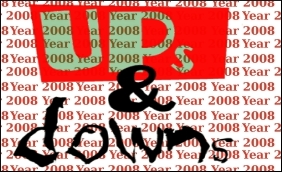|

|
2008: Watershed year for Indian telecom
|
|

|
|
| Top Stories |
 |
|
|
|
Yearender - 2008
For a country that stood at the bottom of the pyramid in terms of telecom penetration a decade ago, 2008 was a watershed when India’s subscriber base topped 350 million users to make its network the second largest in the world after China, displacing the US.
The significant achievement was made possible by the mobile telephony segment of communications, which was once thought to be a gizmo for the rich - what with a tariff of Rs.16.80 per call when the telecom revolution began in the country in the early 1990s. But with tariff falling to 40 paise a call and incoming calls becoming free, mobile telephony began to appeal to the masses.
In fact, 2008 also saw Indian telecom operators add a whopping 8-10 million new subscribers to the network each month, making a host of global companies to look at the country as their next big market for growth, especially in the hinterland.
And the statistics speak for themselves.
As per the watchdog for the sector, the Telecom Regulatory Authority of India (TRAI), the total number of telephone connections in the country reached 363.95 million at the end of October 2008 against 256.55 million in the corresponding month last year.
This, despite the fact that the number of plain vanilla landlines in the country actually fell from 39.41 million in October 2007 to 38.22 million the same month this year. Tele-density shot up from a mere 12.7 percent in March 2006 to 31.5 percent as on Oct 31.
The projection by several leading global consultancies is that India’s telecom network will overtake China’s in the next 10 years.
“The telecom sector in India has registered a remarkable growth during the last few years propelled largely by the unprecedented growth of mobile telephony,” said Nripendra Misra, chairman of the watchdog.
“Three years back, a target of 250 million telephone subscribers by 2007 was considered too ambitious. We could achieve this target a few months ahead of schedule,” Misra told IANS.
“Telecommunication access to rural India is going to be the most important development since the Green Revolution. Research analysts feel that mobile voice is overwhelmingly the engine of growth followed by next generation network, broadband and data.”
The sector, which will go through a major revamp with the launch of third generation (3G) mobile services, has seen a number of ups and downs in the recent past.
A key development in the history of the telecom industry was when Bharti, in collaboration with 15 telecom players, signed a deal to build the first direct, high-bandwidth optical-fibre undersea cable system from Britain to India in May.
Technology travelled distances with Apple iPhone 3G being launched in India by telecom majors Bharti and Vodafone Aug 22.
The international investor community also continued to bet on the Indian market. Norway-based Telenor, the world’s seventh largest telecom operator, bought a new-generation telecom company Unitech Wireless by paying $1.29 billion for a 60 percent stake.
Similarly, another start-up, Swan Telecom, which did not have a single subscriber, sold a 45-percent stake to the UAE’s Etisalat for $900 million, taking the company’s book value to $2 billion.
Another major foreign inflow was announced when Japanese telecom giant NTT DoCoMo picked up 26 percent stake in Tata Teleservices for $ 2.7 billion.
However, the entry of foreign players was marred by major controversies surrounding Swan Telecom and Unitech Wireless. The communications minister was charged with flouting TRAI norms and allocating second generation (2G) spectrum on preferential treatment.
The now estranged government ally, the Communist Party of India-Marxist, raised a hue and cry over the government’s “first-come first-served” principle and the resultant alleged loss of Rs.60,000 crore (Rs.600 billion/$13.2 billion) to the exchequer.
The minister has claimed that the allocation of spectrum was purely based on TRAI’s policies and clarified that both Swan and Unitech had only diluted their stake and that it wasn’t an outright sale.
2G spectrum is nearing saturation, and with the defence yet to vacate the spectrum for both 2G and 3G that it holds, the problem persists.
December saw the much-touted third generation (3G) services being launched by the state-run telecom operator Mahanagar Telephone Nigam Ltd (MTNL). Under the brand ‘Jaadu’ (magic), MTNL ushered in the next wave of Indian telephony Dec 11.
With 3G and broadband wireless access (BWA) auctions a fortnight away, the government held a pre-bid conference to clarify on bidding related issues to the telecom operators and to make them aware of the rules of the game.
Though the turnout of foreign players for the pre-bidding conference was dismal, the Department of Telecommunications (DoT) hoped that it would get a good response Jan 5, the last day for filing applications.
“We are hoping that the auction will draw in bids that are a few times higher than the reserve price of Rs.2,020 crore (Rs.20.2 billion). The global financial crisis will not affect the auction for 3G services,” said R. Ashok, member (Finance), Telecom Commission, the apex government body for the sector.
Consumers had more good news in store, with the government announcing that the much-awaited mobile number portability (MNP) would be implemented in the four metros by June 2009 and extended to other parts of the country.
|
|
|
| |
|
|
|
|
|
|
|
|
|
|
|
|
|
|
| |
| Customs Exchange Rates |
| Currency |
Import |
Export |
US Dollar
|
66.20
|
64.50 |
UK Pound
|
87.50
|
84.65 |
Euro
|
78.25
|
75.65 |
| Japanese
Yen |
58.85 |
56.85 |
| As on 13 Aug, 2022 |
|
|
| Daily Poll |
 |
 |
| PM Modi's recent US visit to redefine India-US bilateral relations |
|
|
|
|
|
| Commented Stories |
 |
|
|
|
|
|
| |
|